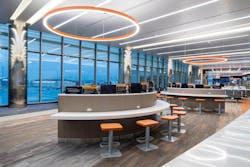The aviation industry has endured and persevered tough times. However, neither the oil crises of the 70s, September 11th terrorist attacks, or economic recession of 2008 had the impact of COVID-19, which has brought an unprecedented decline in passenger traffic. From 2019 to 2020, the International Civil Aviation Organization (ICAO) estimates that, worldwide, the industry saw a 60% reduction in passengers, representing an approximately $371 billion loss of gross passenger operating revenues.
When looking to the future of American airports, it is interesting to explore what specifically is happening in the southernmost state. Florida’s aviation industry has seen impacts that have mirrored the rest of the country. According to the Florida Department of Transportation (FDOT), across the state’s 20 commercial service airports, flight frequencies dropped by 36.1% between 2019 and 2020, and 101 fewer destinations were served. Plus, annual passenger traffic levels are not expected to fully recover until early 2025, about a year behind the projected national recovery date, due to Florida being a hub of international tourism and Latin America gateway.
However, despite this expected delay in a full recovery, due to the strength of the tourism industry and less reliance on business travel, Florida’s airports have seen an accelerated bounce back compared to other states, and the sun is peaking through the clouds with opportunities to be realized and leveraged.
Moving forward, airports across the national might soon receive a Federal boost to renovate or add to their facilities in a post-pandemic image. And as noted, with a strong initial rebound and several new projects either in RFP or soon to begin, Florida will serve as an example of what is to come.
The American Jobs Plan
With fewer travelers, airports are suffering from a significant loss of revenue that typically would come from passenger facility charges (PFCs). With 60% fewer passengers traveling, the hit to project revenue has been significant.
However, in addition to traffic once again picking up, one major factor when it comes to airports planning new projects is the potential passage of a massive new infrastructure bill which would help offset the loss of revenue from PFCs.
The Biden Administration has proposed a new, wide-ranging infrastructure program titled the American Jobs Plan, which some expect to pass as soon as this summer. Within this $2 trillion bill is $25 billion directed toward airports across the country. The caveat of this capital? Funds are instructed to be used in ways that improve the environmental friendliness of the airports.
The American Jobs Plan will boost the aviation industry’s ability to reduce its carbon footprint and will help launch a new era of sustainable and resilient airport operation. What will the plan fund that may contribute to these changes?
- Terminal renovations that will upgrade old facilities and make them both more sustainable and energy efficient, and resistant to climate change impact
- Design changes that incorporate alternative, sustainable power sources
- Multimodal connections, allowing for car-free access to airports
- Electric vehicles to replace the typically diesel or gas operated ground support equipment (GSE) at airports that service aircraft, like tugs and baggage belts loaders and more
Pandemic Influenced Design Changes
The pandemic has forever changed what is considered best practice when designing and building an airport. The new normal surrounding personal space, plus technology that can enable touchless journeys, will become the standard in time.
Part I: Physical Changes
The first major change will come down to space. Roomier waiting areas, queuing lines that allow for passenger separation, new seating layouts in holding rooms, and a more natural separation of passengers emplaning and deplaning must be considered.
Materials used in construction will change as well, as the ability to sanitize surfaces and furniture becomes top of mind for many. One way this may present is in the use of solid, non-porous flooring in areas that once were carpeted.
Health and safety systems are also on the upgrade punch list. HVAC systems that serve terminals will need to be closer to hospital-grade, with enhanced air filtration and virus eliminating technology like UV lights.
Part II: Tech-Based Experiential Changes
While some advanced technology is already in use in certain locations, from facial recognition to self-check-in for bags, implementing these plus more across the board to make “Touchless Journeys” the standard would require major changes to airport infrastructure. Ideally, reimagined airports will allow for a “no wait” process where passengers can go from their home to the aircraft without touching anything – using only their personal device. This will require changes in the journey from check-in, baggage tagging and drop-off, to security checkpoints and boarding.
For this process to work, security checkpoint technology must advance to the point of allowing passengers to continuously walk through without waiting to cut down on lines, all while maintaining the same or better level of security.
It would also mean a change to airport concessions and amenities as they would have to adapt to this new touchless technology format for delivering services while minimizing lines and crowds.
One obstacle to the touchless journey is overall acceptance of data sharing and the need for increased data protection. Passengers must be able to trust that their personal information is safe as it will need to be shared among airlines, airports, TSA and other governmental agencies.
Finally, airports of the future will need to incorporate health screening protocols and procedures to respond quickly in the event of another outbreak. From a technology perspective, this could include inconspicuous technologies that screen and document passenger health throughout their journey. On the response side, new construction must have facilities ready to respond to a new health crisis quickly, efficiently, and safely to maintain passenger confidence and trust in travel.
Florida Aviation Industry Future
Florida has one of the most dynamic and progressive aviation systems in the country with robust air passenger, cargo, and air charter services. However, even within this current leading position, there are opportunities and factors that must be considered to continue meeting the growing demand the market was seeing pre-Pandemic. These include:
- Aviation’s close tie to the Florida economy. As employment levels, population count and median income rises, this will fuel demand for air travel and cargo. As demand increases, so too will congestion in Florida’s major airport hubs. Older airport infrastructure must be upgraded and enlarged to meet future demand.
- A growing, yet again population. Florida is among the top states in terms of new residents each year and has one of the largest populations of adults over the age of 65. The growing population ties back into needing larger facilities, but the percentage of older residents means airports must work to accommodate older travelers albeit via signage, improved audio systems, passenger accommodations, and intermodal connections.
- Entrance of electric aircrafts to the scene. Florida is becoming a central hub for many startup companies looking to augment air and train travel with electric vertical take-off and landing jets. Once certified by the FAA, these high speed, high performance, low noise electric aircraft will revolutionize the regional air mobility system and updates to airports must be made with the upcoming addition of these aircraft in mind.
- Demand for fixed-base operators (FBOs). As more businesses relocate to Florida for its sunny weather and friendly tax structure, private sector flying will only grow, necessitating more accommodation of FBOs. This is an important consideration for any airport expansion projects.
- Expanding transportation links. As Florida is expanding its high-speed passenger network across the state, linking airports to these systems is becoming an ever-important consideration. Airports must plan to build hubs and infrastructure where passengers utilizing these systems can easily access and exit the airport.
The result of this will be an expansion of Florida’s airports that both meet the criteria of American Jobs Plan funding, and advancements that will be replicable in other States.
It is Time to Build
Before the pandemic, many airports were too congested with facilities meant to support far fewer travelers than there were. The temporary slowdown, because the industry is sure to regain prior levels and continue to grow past them soon enough, provides a rare window of opportunity to get ahead of the curve. Now is the time for airports to consider how they can bring new efficiencies, technology, and environmentally friendly changes to the playing field and develop advanced airport hubs that will bring in the future era of aviation.
Sam Sleiman is the Executive Vice President of Transportation, responsible for leading Suffolk’s operations in the transportation sector and driving business development efforts for aviation, port, and railway projects nationally. Sam joined Suffolk from the Massachusetts Port Authority (Massport), with more than 35 years of experience in the design and construction industry. With extensive experience on the client-facing side of operations and capital programming, along with his expertise in managing complex and sophisticated transportation projects, Sam serves an integral role in Suffolk’s growth and diversification throughout the transportation sector. Sam is an active member of Airport Council International (ACI), American Association of Airport Executives (AAE), Construction Management Association of America (CMAA), and American Society of Civil Engineer (ASCE).
About the Author

